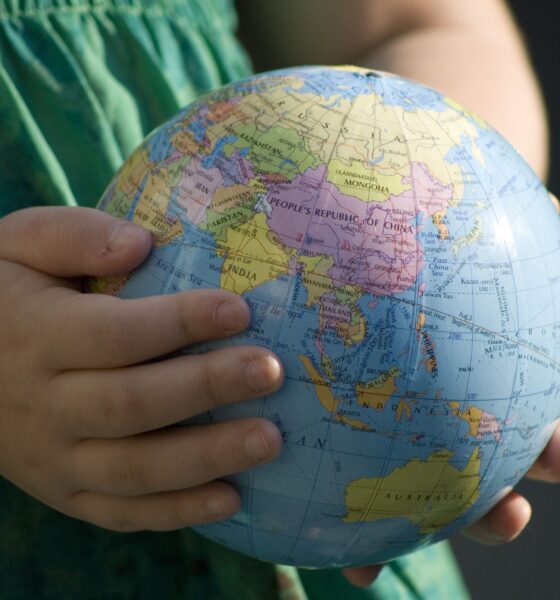

Features
Using visuals to solve ecological illiteracy
In the first of a two-part interview, Joanna Boehnert, founder of design research studio EcoLabs, speaks to B> about the visual communication of complex environmental problems. She begins by outlining the problem she believes her venture is uniquely solving.
EcoLabs uses design and educational methods to support learning about environmental issues.
We develop resources and projects to support ecological literacy (also known as ecoliteracy). Ecoliteracy enables a holistic approach to environmental problems and nurtures critical thinking about the political, economic and cultural processes that perpetuate environmentally harmful activities.
What’s your background?
I grew up in Guelph, Ontario, Canada. I started university studying politics but transferred to fine arts after deciding that the environmental crisis could only be effectively addressed once new attitudes and ways of thinking about our relationship with the natural world were normalised.
I saw art and visual communication as having a role in the development of new ways of perceiving our relationship with nature. I have worked towards this goal ever since.
When I graduated from university, I worked as an artist in Toronto. My first show sold out and I made enough money to go travelling for a year in Europe and India.
When I came back to Canada, I wanted to do more political engaged artwork. I worked on issues of sexual violence against girls and women. Needless to say I was no longer able to make a living from my artwork.
For the next few years, I worked at small enterprises in the creative industries and then as a designer. I moved to London. My commitment to environmental activism grew and I supported many grassroots campaigns and social movements.
I co-founded Transition Towns Brixton in 2006 – transforming a tiny Lambeth Climate Action Group into the first urban transition town in a metropolis.
After a decade exploring creative strategies to address environmental problems, I founded EcoLabs (also in 2006). Over the past seven years, EcoLabs has helped dozens of organisations communicate environmental information. We have also developed self-initiated projects to support ecological learning.
As it became increasingly obvious to me that there were still serious gaps in knowledge in the fields of environmental communication, I started Arts and Humanities Research Council funded PhD in the department of Architecture and Design at the University of Brighton in 2008.
This research, titled The Visual Communication of Ecological Literacy: Designing, Learning and Emergent Ecological Perception is now finished and available on the EcoLabs website.
I am now working on a variety of environmental communication design projects, academic papers and two books. I have been working with the Transition Research Network on developing research to support the transition movement.
In August 2013, I will be moving to Colorado for one year to take a position as visiting research fellow at CIRES, the Cooperative Institute for Research in Environmental Sciences at the University of Colorado. At CIRES I will be working on making large-scale visualisations of issues of the green economy and climate communication.
How would you define ‘ecological literacy’?
Ecological literacy explores the root causes of environmental problems, not just the symptoms.
The aim of ecological literacy is to create the frame of mind that recognises relations and interdependency with the natural world and supports the development of new capacities to create sustainable way of living. Ecological literacy is an approach to sustainability that acknowledges geophysical relationships in such a manner that transforms learning and cultural priorities.
As ecological literacy takes a holistic view of sustainability imperatives, it holds that ecological knowledge must be diffuse and embedded in all disciplines and sectors.
Ecological literacy is especially important in design education since designers are responsible for the creation of sustainable new ways of living. As this goal will only become possible when ecological literacy in embedded in design practice, design education has been a focus for EcoLabs.
Is the UK ecologically literate?
Ecological literacy emphasises the contextual and relational characteristics of ecological wellbeing and sees learning as central to addressing environmental problems. Ultimately, sustainability is not a feature of a particular product but the condition of a culture relative to its impact on ecological systems.
Since the cumulative impact of consumer lifestyles, or the ecological footprint of consumption in the UK is 4.8 global hectares (gha), nothing in our culture is sustainable.
While the behaviour of certain individuals is below the threshold (i.e. they personally use fewer resources and create less population) the gross impact of the collective system is the indicator that matters.
The UK continues this trajectory of unsustainable development largely because those with political power are largely failing to respond to ecologically informed analysis of current industrial practices.
Because ecological literacy is marginal, our capacity to respond effectively to environmental problems is low. Ecological knowledge is a basis informed decisions.
How easy is it to visually communicate ecological problems?
The point is to be effective not to do something that is easy. Images can be effective in the communication of environmental problems because images display context and relationships.
Images can establish hierarchy of information. Images are tools to show details while also showing how these details relate to the ‘bigger picture’. Thus images are excellent tools to reveal the complexity ecological issues.
The Eco-Literacy Map that EcoLabs has created is very interesting. How did you come up with this and what does the map show?
The ‘Eco Literacy Map’ is an A1 poster that provides an overview of the literature review for my PhD in the style of a London tube map. On this poster, individual theorists are stations and the various disciplines that form the basis of my research are the tube lines.
The poster provided an introduction to ecological literacy and addresses the problematic fragmentation in research cultures. It has been downloaded nearly 5,000 times from my website but I am keen to develop this work as a silk-screen print.
I need to find a little funding to make this happen, so if you like this poster and you would buy a silk-screen print of this work, please get in touch.
Further reading:
From austerity to scarcity: the coming global crisis
Melting ice caps, deforestation and dead oceans
The inevitability of easing pressure on humanity’s ecological credit card
































